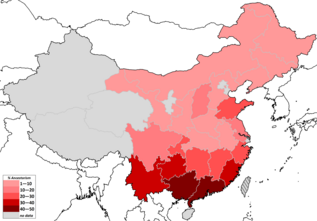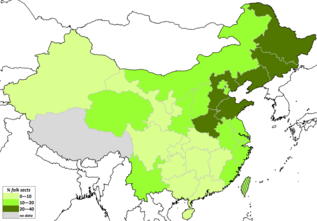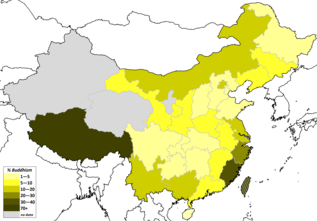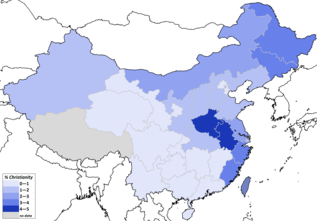چین وچ مذہب
حکومت عوامی جمہوریہ چین نے مذہب دے معاملے وچ ریاستی الحاد دا اعلان کر رکھیا اے۔ پر چینی تمدن تاریخی طور اُتے طویل عرصے توں دنیا وچ مذہبی-فلسفہ روایات دے لئی اک اہم میزبان رہیا اے تے کئی مذاہب ایتھے توں پروان چڑھے نيں۔ کنفیوشس مت تے تاؤ مت، بعد وچ بدھ مت نے وی اس وچ شمولیت اختیار کيتی "تعلیمات ثلاثہ" اُتے مشتمل نيں جنہاں نے چینی سبھیاچار دی تشکیل دی اے۔ اس متغیر مذہبی نظام دے درمیان کوئی واضح حدود نئيں نيں، جو خاص ہونے دا دعوی نئيں کردا اے، تے ہر اک دے عناصر مقبول لوک مذہب نوں فروغ دیندے نيں۔ شہنشاہان چین نے بہشتی تولیت (Mandate of Heaven) دے حق دا دعوی کيتا تے چینی مذہبی رسومات وچ حصہ لیا۔ ویہويں صدی دے آغاز وچ اصلاحات پسند افسران تے دانشوراں نے تمام مذاہب اُتے "غیر معمولی" ہونے دا الزام لگایا تے 1949ء دے بعد توں عوامی جمہوریہ چین وچ چینی کمیونسٹ پارٹی دی حکومت اے جو کہ اک ملحد ادارہ اے جس وچ پارٹی دے ارکان نوں دفتر وچ کِسے قسم دی مذہبی رسوم ادا کرنے توں رکدا اے۔ انیہويں صدی دے اواخر توں الحادی تے مذہب مخالف مہمات دا اک سلسلہ جاری اے، پرانے عادات، خیالات، رواج تے سبھیاچار دے خلاف ثقافتی انقلاب جو کہ 1966ء توں 1967ء تک چلا نے مذہبی قوتاں نوں تباہ کر دتا یا انہاں نوں زیر زمین ہونے اُتے مجبور کر دتا۔[۳][۴] بعد وچ آنے والے رہنماواں نے مذہبی تنظیماں نوں زیادہ خود مختاری دی۔ سرکاری طور اُتے حکومت پنج مذاہب نوں تسلیم کردی اے جو کہ بدھ مت، تاؤ مت، کاتھولک مسیحیت (چینی کاتھولک کلیسیا رومی کاتھولک کلیسیا توں آزاد اے )، پروٹسٹنٹ مسیحیت تے اسلام نيں۔ ویہويں صدی دے آغاز وچ کنفیوشس مت تے چینی لوک مذہب نوں چین دی ثقافتی وراثے دا حصے دے طور اُتے سرکاری طور اُتے تسلیم کرنے وچ اضافہ ہويا اے۔
لوک یا مقبول مذہب تے انہاں دے عقائد تے طریقےآں دا وسیع پیمانے اُتے نظام دا آغاز شانگ دور تے ژؤ دور وچ ہويا۔ مسیحیت تے اسلام جین وچ ستويں صدی وچ آئے۔ چین نوں اکثر انسان دوستی تے سیکولرازم دا اک گھر سمجھیا جاندا اے جس دا آغاز کنفیوشس دور توں ہويا۔
مذاہب بلحاظ صوبہ
[سودھو]| صوبہ | چینی اجداد پرستی[۵] |
بدھ مت[۱۳] | مسیحیت[۱۳] | اسلام[۱۴] |
|---|---|---|---|---|
| فوجیان | 31.31% | 40.40% | 3.97% | 0.32% |
| ژجیانگ | 23.02% | 23.99% | 3.89% | <0.2% |
| گوانگشی | 40.48% | 10.23% | 0.15% | <0.2% |
| گوانگڈونگ | 43.71% | 5.18% | 0.68% | <0.2% |
| یوننان | 32.22% | 13.06% | 0.68% | 1.52% |
| گوئیژو | 31.18% | 1.86% | 0.49% | 0.48% |
| جیانگسو | 16.67% | 14.17% | 2.67% | <0.2% |
| جیانگشی | 24.05% | 7.96% | 0.66% | <0.2% |
| شانڈونگ | 25.28% | 2.90% | 1.54% | 0.55% |
| چونگ چنگ | 26.63% | 0.85% | 0.28% | <0.2% |
| ہونان | 20.19% | 2.44% | 0.49% | <0.2% |
| شنسی | 15.61% | 3.65% | 1.55% | <0.2% |
| ہینان | 7.94% | 5.52% | 4.95% | 1.05% |
| جیلن | 7.73% | 8.23% | 3.26% | <0.2% |
| انہوئی | 4.64% | 7.83% | 4.32% | 0.58% |
| گانسو | 3.51% | 6.85% | 0.28% | 6.64% |
| ہیلونگجیانگ | 7.73% | 4.39% | 3.63% | 0.35% |
| شانسی | 7.58% | 6.35% | 1.66% | 0.4% |
| لیاؤننگ | 7.73% | 5.31% | 1.99% | 0.64% |
| سیچوان | 10.6% | 2.06% | 0.30% | <0.2% |
| ہوبئی | 6.5% | 2.09% | 1.71% | <0.2% |
| ہیبئی | 5.52% | 1.59% | 1.13% | 0.82% |
| ہائنان | – | – | 0.48%[۵] | <0.2% |
| بیجنگ | – | 11.2%[۱۶] | 0.78%[۵] | 1.76% |
| شنگھائی | – | 10.30% | 1.88% | 0.36% |
| تیانجن | – | – | 0.43% | <0.2% |
| تبت | – | ~78%[۱۷] | – | 0.39% |
| سنکیانگ | – | – | 1.0%[۵] | 57.99% |
| نینگشیا | – | – | 1.17%[۵] | 33.99% |
| چنگھائی | – | – | 0.76%[۵] | 17.51% |
| اندرونی منگولیا | 2.36% | 12.1%[۱۸] | 2.0%[۵] | 0.91% |
| چین | 16%[۱۹] | 15%[۲] | 2.5%[۲] | 2%[۱۵]:13 |
ہور ویکھو
[سودھو]- ہور
- چین وچ مسیحیت
- چین وچ اسلام
- اندرونی منگولیا وچ مذہب
- ہانگ کانگ وچ مذہب
- مکاؤ وچ مذہب
- شمال مشرقی چین وچ مذہب
- تائیوان وچ مذہب
حواشی
[سودھو]- ↑ CFPS 2014 surveyed a sample of 13,857 families and 31,665 individuals.[۲]:27, note 4 As noted by Katharina Wenzel-Teuber of China Zentrum, German institute for research on religion in China, compared to CFPS 2012, CFPS 2014 asked the Chinese about personal belief in certain conceptions of divinity (i.e. "Buddha"، "Tao"، "God of the Christians/Jesus"، "Heavenly Lord of the Catholics") rather than membership in a religious group.[۲]:27 It also included regions, such as those in the west of China, that were excluded in CFPS 2012,[۲]:27, note 3 and unregistered Christians.[۲]:28 For these reasons, she concludes that CFPS 2014 results are more accurate than 2012 ones.
- ↑ CFPS 2017 found that 5.94% of the population declared that they belonged to "other" religious categories besides the five state-sanctioned religions. An additional 0.85% of the population responded that they were "Taoists"۔ Note that the title of "Taoist"، in common Chinese usage, is generally attributed only to the Taoist clergy۔ CFPS 2014 found that a further 0.81% declared that they belonged to the popular salvationist sects, while CFPS 2012 found 2.2%، and CGSS 2006–2010 surveys found an average 3% of the population declaring that they belonged to such religions, while government estimates give higher figures (see the "statistics" section of the present article)۔
- ↑ CFPS 2014 surveyed predominantly people of ہان چینی۔ This may have resulted in an underestimation of Muslims. CGSS 2006–2010 surveys found an average 2-3% of the population of China declaring to be Muslim.
- ↑ Chinese ancestral or lineage religion is the worship of kin's ancestor-gods in the system of lineage churches and ancestral shrines. It is worthwhile to note that this does not include other forms of Chinese religion, such as the worship of national ancestral gods or the gods of nature (which in northern China is more common than ancestor worship)، and Taoism and Confucianism.
- ↑ The map represents the geographic diffusion of the tradition of folk religious movements of salvation, Confucian churches and jiaohua ("transformative teachings") movements, based on historical data and contemporary fieldwork. Due to incomplete data and ambiguous identity of many of these traditions the map may not be completely accurate. Sources include a World Religion Map from Harvard University, based on data from the World Religion Database, showing highly unprecise ranges of Chinese folk (salvationist) religions' membership by province. Another source, the studies of China's Regional Religious System، find "very high activity of popular religion and secret societies and low Buddhist presence in northern regions, while very high Buddhist presence in the southeast"۔[۶]
Historical record and contemporary scholarly fieldwork testify certain central and northern provinces of China as hotbeds of folk religious sects and Confucian religious groups.
- ہیبئی: Fieldwork by Thomas David Dubois[۷] testifies the dominance of folk religious movements, specifically the Church of the Heaven and the Earth and the Church of the Highest Supreme، since their "energetic revival since the 1970s" (p. 13)، in the religious life of the counties of Hebei. Religious life in rural Hebei is also characterised by a type of organisation called the benevolent churches and the salvationist movement known as Zailiism has returned active since the 1990s.
- ہینان: According to Heberer and Jakobi (2000)[۸] Henan has been for centuries a hub of folk religious sects (p. 7) that constitute significant focuses of the religious life of the province. Sects present in the region include the Baguadao or Tianli ("Order of Heaven") sect, the Dadaohui, the Tianxianmiaodao، the Yiguandao، and many others. Henan also has a strong popular Confucian orientation (p. 5)۔
- شمال مشرقی چین: According to official records by the then-government, the Universal Church of the Way and its Virtue or Morality Society had 8 million members in منچوریا، or northeast China in the 1930s, making up about 25% of the total population of the area (note that the state of Manchuria also included the eastern end of modern-day Inner Mongolia)۔[۹] Folk religious movements of a Confucian nature, or Confucian churches, were in fact very successful in the northeast.
- شانڈونگ: The province is traditionally a stronghold of Confucianism and is the area of origin of many folk religious sects and Confucian churches of the modern period, including the Universal Church of the Way and its Virtue, the Way of the Return to the One (皈依道 Guīyīdào)، the Way of Unity (一貫道 Yīguàndào)، and others. Alex Payette (2016) testifies the rapid growth of Confucian groups in the province in the 2010s.[۱۰]
- ↑ The statistics for Chinese ancestorism, that is the worship of ancestor-gods within the lineage system, are from the Chinese Spiritual Life Survey of 2010.[۵] The statistics for Buddhism and Christianity are from the China Family Panel Studies survey of 2012.[۱۳] The statistics for Islam are from a survey conducted in 2010.[۱۴] It is worthwhile to note that the populations of Chinese ancestorism and Buddhism may overlap, even with the large remaining parts of the population whose belief is not documented in the table. The latter, the uncharted population, may practise other forms of Chinese religion, such as the worship of gods, Taoism, Confucianism and folk salvationisms, or may be atheist. Indeed, according to the CFPS 2012, only 6.3% of the Chinese were irreligious in the sense of "atheism"، while the rest practised the worship of gods and ancestors.[۱۵]:13
حوالے
[سودھو]- ↑ For China Family Panel Studies 2017ء survey results see release #1 (archived) and release #2 (archived)۔ The tables also contain the results of CFPS 2012 (sample 20,035) and Chinese General Social Survey (CGSS) results for 2006, 2008 and 2010 (samples ~10.000/11,000)۔ Also see, for comparison CFPS 2012 data in سانچہ:Cite article p. 13, reporting the results of the CGSS 2006, 2008, 2010 and 2011, and their average (fifth column of the first table)۔
- ↑ ۲.۰ ۲.۱ ۲.۲ ۲.۳ ۲.۴ ۲.۵ ۲.۶ سانچہ:Cite article
- ↑ (9 May 2014) Muslim Education in the 21st Century: Asian Perspectives (in English). Routledge, 75. ISBN 978-1-317-81500-6. “Subsequently, a new China was found on the basis of Communist ideology, i.e. atheism. Within the framework of this ideology, religion was treated as a 'contorted' world-view and people believed that religion would necessarily disappear at the end, along with the development of human society. A series of anti-religious campaigns was implemented by the Chinese Communist Party from the early 1950s to the late 1970s. As a result, in nearly 30 years between the beginning of the 1950s and the end of the 1970s, mosques (as well as churches and Chinese temples) were shut down and Imams involved in forced 're-education'.”
- ↑ (2009) Religions in the Modern World: Traditions and Transformations, 2nd, London: Routledge. ISBN 0-415-45890-0. OCLC 237880815.
- ↑ ۵.۰ ۵.۱ ۵.۲ ۵.۳ ۵.۴ ۵.۵ ۵.۶ ۵.۷ ۵.۸ Data from the Chinese Spiritual Life Survey (CSLS) 2010 for Chinese ancestorists, and from the Chinese General Social Survey (CGSS) 2009 for Christians. Reported in سانچہ:Cite article
- ↑ سانچہ:Cite article
- ↑ Dubois (2005).
- ↑ سانچہ:Cite article
- ↑ Ownby (2008).
- ↑ Payette (2016).
- ↑ سانچہ:Cite article p. 13. The report compares the data of the China Family Panel Studies 2012 with those of the Renmin University's Chinese General Social Survey (CGSS) of the years 2006, 2008, 2010 and 2011.
- ↑ سانچہ:Cite map The map illustrates local religion led by Taoist specialists, forms and institutions.
- ↑ ۱۳.۰ ۱۳.۱ ۱۳.۲ ۱۳.۳ ۱۳.۴ Data from the China Family Panel Studies (CFPS) 2012. Reported in سانچہ:Cite article
- ↑ ۱۴.۰ ۱۴.۱ ۱۴.۲ Data from سانچہ:Cite article Reported in سانچہ:Cite article p. 29.
- ↑ ۱۵.۰ ۱۵.۱ سائیٹ غلطی: نا منیا جان والا
<ref>ٹیگ کوئی لکھت نئیں دتی گئی اتے پتےCFPS2012لئی۔ - ↑ Lai, Hongyi (2016). China's Governance Model: Flexibility and Durability of Pragmatic Authoritarianism. Routledge. ISBN 978-1-317-85952-9. p. 167.
- ↑ "Internazional Religious Freedom Report 2012" (PDF)۔ US Government p. 20, quoting: "Most ethnic Tibetans practice Tibetan Buddhism, although a sizeable minority practices Bon, an indigenous religion, and very small minorities practice Islam, Catholicism, or Protestantism. Some scholars estimate that there are as many as 400,000 Bon followers across the Tibetan Plateau. Scholars also estimate that there are up to 5,000 ethnic Tibetan Muslims and 700 ethnic Tibetan Catholics in the TAR"۔
- ↑ سانچہ:Cite article Note that the article, in an evident mistranslation from Chinese, reports 30 million Tibetan Buddhists in Inner Mongolia instead of 3 million.
- ↑ سائیٹ غلطی: نا منیا جان والا
<ref>ٹیگ کوئی لکھت نئیں دتی گئی اتے پتےCSLS2010لئی۔
ماخذ
[سودھو]- Lua error in package.lua at line 80: module 'Module:Citation/CS1/COinS' not found.۔ Available at the author's website: Joseph Adler Department of Religious Studies, کینین کالج۔
- Lua error in package.lua at line 80: module 'Module:Citation/CS1/COinS' not found.۔
- سانچہ:Cite conference
- Bays, Daniel H. (2012). A New History of Christianity in China. Chichester, West Sussex; Malden, MA: Wiley-Blackwell. ISBN 978-1-4051-5954-8.
- Billioud, Sébastien (2010). "Carrying the Confucian Torch to the Masses: The Challenge of Structuring the Confucian Revival in the People's Republic of China" (PDF). OE 49. http://www.oriens-extremus.de/inhalt/pdf/49/OE49-09.pdf.
- (2015) The Sage and the People: The Confucian Revival in China. Oxford University Press. ISBN 0-19-025814-4.
- Chan, Kim-Kwong (2005). "Religion in China in the Twenty-first Century: Some Scenarios". Religion, State & Society 33 (2). doi:.
- Chang, Ruth H. (2000). "Understanding Di and Tian: Deity and Heaven from Shang to Tang Dynasties" (PDF). Sino-Platonic Papers (Victor H. Mair) (108). ISSN 2157-9679. http://www.sino-platonic.org/complete/spp108_chinese_deity_heaven.pdf.
- Chau, Adam Yuet (2005). Miraculous Response: Doing Popular Religion in Contemporary China. ISBN 978-0-8047-5160-5.
- Chen, Yong (2012). Confucianism as Religion: Controversies and Consequences. Brill. ISBN 9004243739.
- Ching, Julia (1993). Chinese Religions. Houndsmills; London: Macmillan. ISBN 978-0-333-53174-7. Various reprints.
- Lua error in package.lua at line 80: module 'Module:Citation/CS1/COinS' not found.
- Clart, Philip (2003). "Confucius and the Mediums: Is There a "Popular Confucianism"?" (PDF). T'oung Pao (Leiden: Brill) LXXXIX. http://home.uni-leipzig.de/clartp/Clart%202003.pdf.
- Lua error in package.lua at line 80: module 'Module:Citation/CS1/COinS' not found.
- De Groot, J.J.M. (1892). The Religious System of China: Its Ancient Forms, Evolution, History and Present Aspect, Manners, Customs and Social Institutions Connected Therewith. Leiden, Netherlands: Brill. 6 volumes. Online: Les classiques des sciences sociales, Université du Québec à Chicoutimi; Scribd: Vol. 1، Vol. 2، Vol. 3، Vol. 4، Vol. 5، Vol. 6۔
- Didier, John C. (2009). "In and Outside the Square: The Sky and the Power of Belief in Ancient China and the World, c. 4500 BC – AD 200". Sino-Platonic Papers (Victor H. Mair) (192). Volume I: The Ancient Eurasian World and the Celestial Pivot، Volume II: Representations and Identities of High Powers in Neolithic and Bronze China، Volume III: Terrestrial and Celestial Transformations in Zhou and Early-Imperial China۔
- Do, Thien (2003). Vietnamese Supernaturalism: Views from the Southern Region, Anthropology of Asia. Routledge. ISBN 0-415-30799-6.
- Dubois, Thomas David (2005). The Sacred Village: Social Change and Religious Life in Rural North China (PDF), University of Hawaii Press. ISBN 0-8248-2837-2. Archived 2017-01-10 at the وے بیک مشین
- Lua error in package.lua at line 80: module 'Module:Citation/CS1/COinS' not found.۔ Consulted HAL-SHS version، pages 1–56.
- Lua error in package.lua at line 80: module 'Module:Citation/CS1/COinS' not found.
- Fan, Lizhu; Chen, Na (2013). "The Revival of Indigenous Religion in China" (PDF). China Watch (Fudan University، Fudan-UC Center for China Studies). doi:. http://fudan-uc.ucsd.edu/_files/201306_China_Watch_Fan_Chen.pdf. Preprint from The Oxford Handbook of Religious Conversion، 2014.
- Fan, Lizhu; Chen, Na (2015). "The Religiousness of "Confucianism" and the Revival of Confucian Religion in China Today". Cultural Diversity in China (De Gruyter Open) (1): 27–43. doi:. ISSN 2353-7795.
- Fingarette, Herbert (1972). Confucius: The Secular as Sacred. New York City: Harper.
- Lua error in package.lua at line 80: module 'Module:Citation/CS1/COinS' not found.۔
- Fowler, Jeanine D. (2005). An Introduction to the Philosophy and Religion of Taoism: Pathways to Immortality. Sussex Academic Press. ISBN 1-84519-086-6.
- Lua error in package.lua at line 80: module 'Module:Citation/CS1/COinS' not found.۔
- (2015) Popular Belief in Contemporary China: A Discourse Analysis. Projekt Verlag. ISBN 0-226-30416-7.
- (2011) The Religious Question in Modern China. University of Chicago Press. ISBN 0-226-30416-7.
- Jing, Jun (1996). The Temple of Memories: History, Power, and Morality in a Chinese Village. Stanford University Press. ISBN 0-8047-2756-2.
- Johnson, Ian (2017). The Souls of China: The Return of Religion after Mao. New York: Pantheon Books. ISBN 978-1-101-87005-1.
- Kao, Yaning (2014). "Religious Revival among the Zhuang People in China: Practising "Superstition" and Standardizing a Zhuang Religion". Journal of Current Chinese Affairs 43 (2): 107–144. ISSN 2353-7795. سانچہ:Catalog lookup link (online)، سانچہ:Catalog lookup link (print)۔
- Lua error in package.lua at line 80: module 'Module:Citation/CS1/COinS' not found.
- Kraef, Olivia (2014). "Of Canons and Commodities: The Cultural Predicaments of Nuosu-Yi "Bimo Culture"". Journal of Current Chinese Affairs 43 (2): 145–179.
- Lagerwey, John (2010). China: A Religious State. Hong Kong: University of Hong Kong Press. ISBN 9888028049.
- (2008) Early Chinese Religion: Part One: Shang Through Han (1250 BC-220 AD), Early Chinese Religion. Brill. ISBN 9004168354.
- (2009) Early Chinese Religion, Part Two: The Period of Division (220-589 AD), Early Chinese Religion. Brill. ISBN 904742929X.
- (2014) Modern Chinese Religion I: Song-Liao-Jin-Yuan (960-1368 AD), Modern Chinese Religion. Brill. ISBN 9004271643.
- (2015) Modern Chinese Religion II: 1850–2015, Modern Chinese Religion. Brill. ISBN 9004304649.
- Laliberté, André (2011). "Religion and the State in China: The Limits of Institutionalization". Journal of Current Chinese Affairs 40 (2): 3–15. http://journals.sub.uni-hamburg.de/giga/jcca/article/view/415/413.
- Law, Pui-Lam (2005). "The Revival of Folk Religion and Gender Relationships in Rural China: A Preliminary Observation". Asian Folklore Studies 64: 89–109. http://nirc.nanzan-u.ac.jp/nfile/672.
- Libbrecht, Ulrich (2007). Within the Four Seas.۔۔: Introduction to Comparative Philosophy. Peeters Publishers. ISBN 9042918128.
- Littlejohn, Ronnie (2010). Confucianism: An Introduction. I. B. Tauris. ISBN 1-84885-174-X.
- (2014) Marxism and Religion, Religious Studies in Contemporary China. Brill. ISBN 9047428021.
- Madsen, Richard (2010). "The Upsurge of Religion in China" (PDF). Journal of Democracy 21 (4): 58–71. http://www.journalofdemocracy.org/articles-files/gratis/Madsen-21-4.pdf. Archived 2017-07-14 at the وے بیک مشین
- Miller, James (2006). Chinese Religions in Contemporary Societies. ABC-CLIO. ISBN 1-85109-626-4.
- Nadeau, Randal L. (2012). The Wiley-Blackwell Companion to Chinese Religions. Malden, MA: Blackwell.
- Overmyer, Daniel L. (2009). Local Religion in North China in the Twentieth Century the Structure and Organization of Community Rituals and Beliefs (PDF), Leiden; Boston: Brill. ISBN 9789047429364.
- Overmyer, Daniel L. (1986). Religions of China: The World as a Living System. New York: Harper & Row.
- Overmyer, Daniel (2003). Religion in China Today. Cambridge University Press. ISBN 0-521-53823-8.
- Ownby, David (2008). "Sect and Secularism in Reading the Modern Chinese Religious Experience". Archives de sciences sociales des religions 144. doi:. http://assr.revues.org/17633.
- (2011) Chinese Religious Life. Oxford University Press. ISBN 0-19-973138-1.
- Palmer, David A. (2011). "Chinese Redemptive Societies and Salvationist Religion: Historical Phenomenon or Sociological Category?" (PDF). Journal of Chinese Ritual, Theatre and Folklore 172: 21–72. http://hub.hku.hk/bitstream/10722/139685/1/Content.pdf?accept=1.
- (2013) Astrology and Cosmology in Early China. Cambridge University Press. ISBN 1-107-00672-4.
- Pas, Julian F. (1998). Historical Dictionary of Taoism, Historical Dictionaries of Religions, Philosophies, and Movements Series. Scarecrow Press. ISBN 0-8108-6637-4.
- Payette, Alex (فروری 2016). "Local Confucian Revival in China: Ritual Teachings, 'Confucian' Learning and Cultural Resistance in Shandong". China Report 52 (1): 1–18. doi:. http://chr.sagepub.com/content/52/1/1.abstract.
- Lua error in package.lua at line 80: module 'Module:Citation/CS1/COinS' not found.
- Pregadio, Fabrizio (2013). The Encyclopedia of Taoism. Routledge. ISBN 1-135-79634-3. Two volumes: 1) A-L; 2) L-Z.
- Lua error in package.lua at line 80: module 'Module:Citation/CS1/COinS' not found.
- Lua error in package.lua at line 80: module 'Module:Citation/CS1/COinS' not found.
- Lua error in package.lua at line 80: module 'Module:Citation/CS1/COinS' not found.
- Lua error in package.lua at line 80: module 'Module:Citation/CS1/COinS' not found.
- (1996) Unruly Gods: Divinity and Society in China. University of Hawaii Press. ISBN 0-8248-1724-9.
- (2007) Confucian Ethics in Retrospect and Prospect. Council for Research in Values & Philosophy. ISBN 1-56518-245-6.
- Shi, Yilong 石奕龍 (2008). "中国汉人自发的宗教实践 – 神仙教 (Zhongguo Hanren zifadi zongjiao shijian: Shenxianjiao)". 中南民族大学学报 — 人文社会科学版 (Journal of South-Central University for Nationalities – Humanities and Social Sciences) 28 (3): 146–150. http://www.doc88.com/p-2949949083043.html. Archived 2019-08-31 at the وے بیک مشین
- Tay, Wei Leong (2010). "Kang Youwei: The Martin Luther of Confucianism and His Vision of Confucian Modernity and Nation" (PDF). Secularization, Religion and the State (University of Tokyo Center of Philosophy). http://utcp.c.u-tokyo.ac.jp/publications/pdf/UTCPBooklet17_08_Tay.pdf.
- Teiser, Stephen F. (1988). The Ghost Festival in Medieval China. Princeton, N.J.: Princeton University Press.
- Lua error in package.lua at line 80: module 'Module:Citation/CS1/COinS' not found.۔ Extracts in The Chinese Cosmos: Basic Concepts۔
- Teiser, Stephen F. (1995). "Popular Religion". Journal of Asian Studies 54 (2): 378–395. doi:.
- Waldron, Arthur (1998). "Religious Revivals in Communist China". Orbis 42 (2): 325–334. http://www2.kenyon.edu/Depts/Religion/Fac/Adler/Reln270/Waldron-revivals.htm.
- Xie, Zhibin (2006). Religious Diversity and Public Religion in China. Ashgate Publishing. ISBN 978-0-7546-5648-7.
- (2012) Social Scientific Studies of Religion in China. Brill. ISBN 9004182462.
- Yang, C.K. (1961). Religion in Chinese Society: A Study of Contemporary Social Functions of Religion and Some of Their Historical Factors. Berkeley: University of California Press. ISBN 0-520-01371-9.
- Yang, Mayfair Mei-hui (2007). "Ritual Economy and Rural Capitalism with Chinese Characteristics", Cultural Politics in a Global Age: Uncertainty, Solidarity and Innovation (PDF), Oxford: Oneworld Publications. ISBN 1-85168-550-2.
- Yang, Fenggang; Hu, Anning (2012). "Mapping Chinese Folk Religion in Mainland China and Taiwan". Journal for the Scientific Study of Religion 51 (3): 505–521. doi:.
- (2010) Chinese Religion: A Contextual Approach. London: A&C Black. ISBN 978-1-84706-475-2.
- Zhou, Jixu (2005). "Old Chinese "*tees" and Proto-Indo-European "*deus": Similarity in Religious Ideas and a Common Source in Linguistics" (PDF). Sino-Platonic Papers (Victor H. Mair) (167). http://www.sino-platonic.org/complete/spp167_old_chinese_proto_indo_european.pdf.
- Zhou, Youguang (2012). "To Inherit the Ancient Teachings of Confucius and Mencius and Establish Modern Confucianism" (PDF). Sino-Platonic Papers (Victor H. Mair) (226). http://www.sino-platonic.org/complete/spp226_zhou_youguang_modern_confucianism.pdf.
ہور پڑھو
[سودھو]- Ch'en, Kenneth K. S. (1972). Buddhism in China, a Historical Survey. Princeton, NJ: Princeton University Press. ISBN 0-691-00015-8.
- Paper, Jordan D. (1995). The Spirits are Drunk: Comparative Approaches to Chinese Religion. Albany, NY: State University of New York Press. ISBN 0-7914-2315-8.
- Wright, Arthur F. (1959). Buddhism in Chinese History. Stanford University Press. ISBN 0-8047-0548-8.
باہرلے جوڑ
[سودھو]| وکیمیڈیا کامنز چ مورتاں: چین وچ مذہب |
- Chinese Buddhist Association
- China Confucian Philosophy
- China Confucian Religion
- China Confucian Temples Archived 2014-05-17 at the وے بیک مشین
- Holy Confucian Church of China Archived 2018-11-11 at the وے بیک مشین
- Chinese Taoist Association
- Chinese Folk Temples' Management Association Archived 2018-08-16 at the وے بیک مشین
تعلیمی
- Living in the Chinese Cosmos، Asia for Educators, Columbia University.
- China Zentrum، Germany-based institute for research on religion in China
میڈیا
- Euraxess Science Slam: Meihuaquan and Community Life in North China
- eRenlai Ricci: The boundary between religion and the state in China by Prof. Lagerwey
- GBTimes: THE DEBATE: Insight into religion in modern China (part 1)—Part 2
- Berkeley Center: Ritual Economy and Religious Revivial in Rural Southeast China
- Berkeley Center: Secularization Theory and the Study of Chinese Religions
- Berkeley Center: Understanding Contemporary Religious Pluralism in China
| ||||||||||||||







